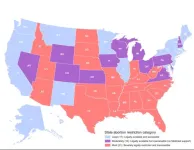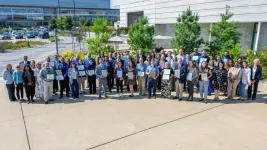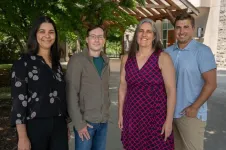Strictest abortion-ban states offer least family support
'Pro-life attitude begins at conception but ends there as well'
2024-09-04
(Press-News.org) View a breakdown of the abortion restrictions by state below
States with early abortion bans are less likely to offer paid time off after childbearing, to give poor children nutritional support or to expand access to reproductive health care
Marginalized people and those with low socioeconomic status are overrepresented in ban states and least likely to overcome the barriers that bans impose
CHICAGO --- States with the most severe post-Dobbs abortion restrictions also have the fewest policies in place to support raising families, reports a new Northwestern Medicine study.
“We found that in the states that most severely restrict abortion, the women, children and families that abortion proponents seek to ‘protect’ are the populations that are left behind — with less access to health care and family social services — when pregnancy is continued,” said lead and corresponding author Dr. Nigel Madden, a recent graduate of the fellowship in maternal-fetal medicine at Northwestern University Feinberg School of Medicine and now an instructor at Harvard Medical School and physician at Beth Israel Deaconess Medical Center.
The study will be published Sept. 4 in the American Journal of Public Health.
This is one of the only academic studies to systematically examine the intersection between post-Dobbs state abortion policy and state access to reproductive health care and family social policies and programs. (A breakdown of the abortion restrictions by state is below).
“Proponents of abortion restrictions, who identify as ‘pro-life,’ assert that these policies are essential to protect children, women and families,” said senior author Dr. Lynn Yee, associate professor of obstetrics and gynecology at Feinberg and a Northwestern Medicine physician. “It would seem in these states that the abortion opponent, ‘pro-life’ attitude not only begins at conception but ends there as well.”
Certain groups disproportionally bear a greater burden from abortion bans, the study authors said. People of low socioeconomic status and marginalized people are more likely to seek abortion, previous research has found. They’re also less likely to be able to overcome the barriers imposed by abortion bans and restrictions, such as needing to travel out of state to receive care.
How support is lacking
Compared to the least restrictive states, the study found states with more severe abortion restrictions are:
More likely to have lower enrollment in state-funded assistance programs, such as the nutrition-assistance Women, Infants and Children (WIC) program or the Temporary Assistance for Needy Families (TANF) program, because women and families in these states are required to be poorer to qualify for these programs
Less likely to implement policies that support families, such as paid family leave. Of the states with the most restrictive abortion bans, none have a mandatory paid family leave policy
More likely to limit access to reproductive health care
Less likely to have policies in place that allow for pharmacists to prescribe birth control (42.9% vs. 82.4% of the least restrictive states)
“The degree to which these states fail to support their most disadvantaged populations warrants immediate attention and action,” said co-author Katie Watson, professor of medical education, medical social sciences and obstetrics and gynecology at Feinberg. “Advocates should take this opportunity to leverage the child protection arguments of anti-abortion policymakers and encourage them to put their money where their mouth is by advocating for the implementation and improvement of policies that support individual and family well-being.”
This might include adding new policies like postpartum Medicaid expansion or paid family and medical leave; increasing eligibility for state-based assistance programs like WIC and TANF or creating new programs like mobile health clinics to serve pregnant people in maternity care deserts, the study authors said.
Breakdown of abortion restrictions by state
The study categorized states into three post-Dobbs abortion-restriction groups based on state abortion policies as of December 2023 (see map):
Most restrictive group: Includes 21 states in which abortion is severely restricted, 14 of which have complete abortion bans with very limited exceptions and 7 of which have an early gestational age ban of 6 to 18 weeks’ gestation
Moderately restrictive group: Includes states in which abortion is legally available, but Medicaid coverage of abortion is prohibited, making abortion largely inaccessible to a significant portion of the population. These states also often have additional restrictive and burdensome policies (i.e. waiting periods, mandatory parental notification for monitors, etc.) in place
Least restrictive group: Includes states in which abortion is both legally available and accessible. These states have either no gestational age ban or ban abortion at 24 weeks’ gestation or later and allow Medicaid funds to pay for abortion
END
[Attachments] See images for this press release:


ELSE PRESS RELEASES FROM THIS DATE:
2024-09-04
In simulated life-or-death decisions, about two-thirds of people in a UC Merced study allowed a robot to change their minds when it disagreed with them -- an alarming display of excessive trust in artificial intelligence, researchers said.
Human subjects allowed robots to sway their judgment despite being told the AI machines had limited capabilities and were giving advice that could be wrong. In reality, the advice was random.
“As a society, with AI accelerating so quickly, we need to be concerned about the potential for overtrust,” said Professor Colin ...
2024-09-04
City leaders who are working to accommodate more electric vehicles (EVs) were recognized in a ceremony o Aug. 23 at the U.S. Department of Energy’s (DOE) Argonne National Laboratory. Utility ComEd and the Metropolitan Mayors Caucus spotlighted 12 communities in northern Illinois that recently completed the EV Readiness Program.
The EV Readiness Program trains and assists local government officials in taking concrete steps to support EV adoption. As a national leader in EV research, ...
2024-09-04
WASHINGTON, D.C.—A new survey by the Physicians Committee for Responsible Medicine published in the American Journal of Lifestyle Medicine reveals that 69.2% of U.S. hospitals affiliated with a medical school host at least one fast-food restaurant. The five most common fast-food restaurants located in hospitals were Starbucks, Subway, Chick-fil-A, Au Bon Pain, and McDonald’s.
“Making fast food like cheeseburgers and fried chicken available in hospitals is hazardous to the health of patients, visitors, and staff,” says Zeeshan Ali, PhD, the lead author of the paper and a nutrition program specialist with the Physicians Committee. “Hospitals ...
2024-09-04
DURHAM, N.C. – A treatment paradox has recently come to light in prostate cancer: Blocking testosterone production halts tumor growth in early disease, while elevating the hormone can delay disease progression in patients whose disease has advanced.
The inability to understand how different levels of the same hormone can drive different effects in prostate tumors has been an impediment to the development of new therapeutics that exploit this biology.
Now, a Duke Cancer Institute-led study, performed ...
2024-09-04
New research published in the Journal of Sport and Health Science led by the University of Massachusetts Amherst shows that super spikes, scientifically described as advanced footwear technology (AFT) spikes, can give runners about a 2% edge in middle-distance track races, like the 800- and 1,500-meters.
“Track athletes started wearing super spikes about five years ago and they are now commonplace in elite track races,” says Wouter Hoogkamer, assistant professor of kinesiology at UMass Amherst and senior author ...
2024-09-04
WASHINGTON, D.C. -Ten Energy Frontier Research Centers (EFRCs) designed to bring together world-class teams of scientists for groundbreaking fundamental research have been funded in nine states by the U.S. Department of Energy (DOE).
Since 2009, EFRCs have brought together diverse, world-class teams of scientists to perform basic research that accelerates ground-breaking scientific advances underlying energy technologies.
The centers develop powerful new tools for characterizing, understanding, modeling, and manipulating matter, while training the next-generation scientific workforce by attracting talented students passionate about energy science.
“Fundamental ...
2024-09-04
The American College of Cardiology (ACC) Quality Summit 2024 will take place on September 17-19 in San Antonio, bringing together cardiovascular leaders from across the nation to discuss the value of NCDR services and quality programs.
“ACC’s Quality Summit puts the spotlight on the value of ACC Accreditation and NCDR services for improving health care quality across all health systems,” said ACC Quality Summit Chair Olivia N. Gilbert, MD, MSc, FACC, and Director of Quality and Value for Cardiovascular Medicine at Atrium Health Wake Forest ...
2024-09-04
Flexcon Global has exclusively licensed two patented inventions to manufacture a self-healing barrier film from the Department of Energy’s Oak Ridge National Laboratory for research and development purposes. The film can be incorporated into vacuum insulation panels to increase the efficiency of buildings during retrofits.
Flexcon, based in Spencer, Massachusetts, provides coatings, film laminations and functional technologies to a range of markets including healthcare, sustainable packaging, transportation, consumer durables, electronics, industrial, retail and advertising.
Under ...
2024-09-04
Poroid fungi, commonly known as "polypores," are among the most frequently encountered fungi throughout the year because of their large size and longevity. Despite the common presence of poroid fungi in North America, most guides include only a limited selection of these fungi. Poroid Fungi of North America, by Leif Ryvarden, offers a necessary, updated account of these fungi, building on the foundational work of the original two-volume North American Polypores, by Ryvarden and R. L. Gilbertson, published in 1987. This comprehensive update incorporates more than three decades of new research, featuring detailed keys, descriptions, and vibrant color ...
2024-09-04
Four faculty members from three departments in the College of Natural Resources and Environment have received $1.7 million from the National Science Foundation to fund research into the dynamics of socio-environmental factors impacting coastal fisheries.
Holly Kindsvater and Willandia Chaves of the Department of Fish and Wildlife Conservation, Craig Ramseyer of the Department of Geography, and Michael Sorice of the Department of Forest Resources and Environmental Conservation will collaborate with Jonathan van Senten and Fernando Gonçalves of the Virginia Seafood Agricultural Research ...
LAST 30 PRESS RELEASES:
[Press-News.org] Strictest abortion-ban states offer least family support
'Pro-life attitude begins at conception but ends there as well'







